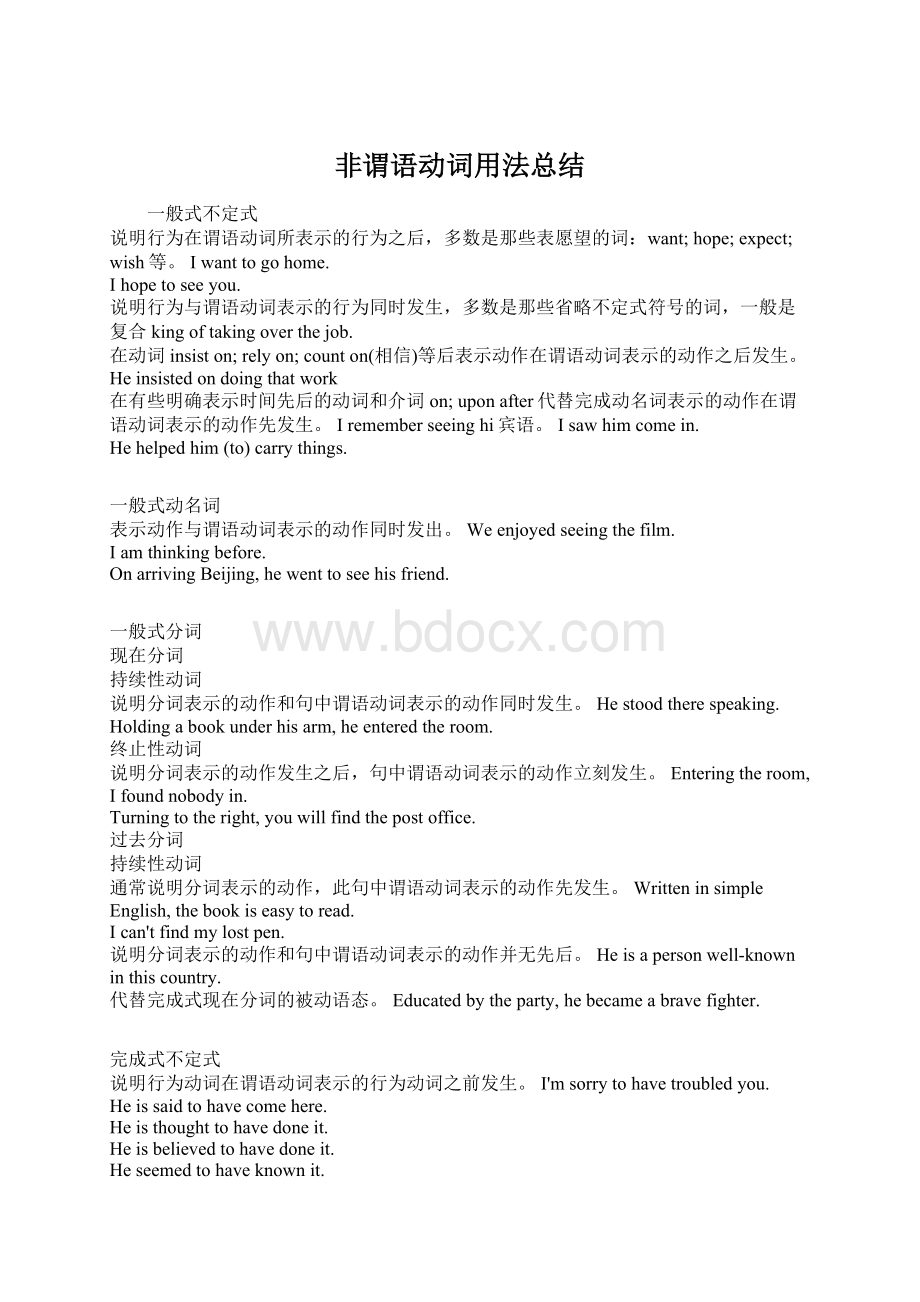非谓语动词用法总结.docx
《非谓语动词用法总结.docx》由会员分享,可在线阅读,更多相关《非谓语动词用法总结.docx(7页珍藏版)》请在冰豆网上搜索。

非谓语动词用法总结
一般式不定式
说明行为在谓语动词所表示的行为之后,多数是那些表愿望的词:
want;hope;expect;wish等。
Iwanttogohome.
Ihopetoseeyou.
说明行为与谓语动词表示的行为同时发生,多数是那些省略不定式符号的词,一般是复合kingoftakingoverthejob.
在动词insiston;relyon;counton(相信)等后表示动作在谓语动词表示的动作之后发生。
Heinsistedondoingthatwork
在有些明确表示时间先后的动词和介词on;uponafter代替完成动名词表示的动作在谓语动词表示的动作先发生。
Irememberseeinghi宾语。
Isawhimcomein.
Hehelpedhim(to)carrythings.
一般式动名词
表示动作与谓语动词表示的动作同时发出。
Weenjoyedseeingthefilm.
Iamthinkingbefore.
OnarrivingBeijing,hewenttoseehisfriend.
一般式分词
现在分词
持续性动词
说明分词表示的动作和句中谓语动词表示的动作同时发生。
Hestoodtherespeaking.
Holdingabookunderhisarm,heenteredtheroom.
终止性动词
说明分词表示的动作发生之后,句中谓语动词表示的动作立刻发生。
Enteringtheroom,Ifoundnobodyin.
Turningtotheright,youwillfindthepostoffice.
过去分词
持续性动词
通常说明分词表示的动作,此句中谓语动词表示的动作先发生。
WritteninsimpleEnglish,thebookiseasytoread.
Ican'tfindmylostpen.
说明分词表示的动作和句中谓语动词表示的动作并无先后。
Heisapersonwell-knowninthiscountry.
代替完成式现在分词的被动语态。
Educatedbytheparty,hebecameabravefighter.
完成式不定式
说明行为动词在谓语动词表示的行为动词之前发生。
I'msorrytohavetroubledyou.
Heissaidtohavecomehere.
Heisthoughttohavedoneit.
Heisbelievedtohavedoneit.
Heseemedtohaveknownit.
在wish,hope,expect,intend,mean,suppose等动词过去时后,说明行为动词没有实现。
Wewishedtohavedonethis.
Iexpectedtohaveleftbythen.
(=Ihadexpectedtoheavebythen.)
完成式动名词
说明动名词表示的动作,此句中动词表示的动作先发生。
Weregrethavingtoldyouthenews.
Afterhavingfinishedhiswork,hewenthome.
Hedeniedhavingbroketheglasses.
完成式分词
说明分词表示的动作,此句中谓语动词表示的动作先发生。
多数表示一些瞬时间动词。
如果是hear;see或表示位置转移的动词arrive;leave;turn;open.不用完成时Havingfinishedhiswork,hewenthome.
Sittingdownwithhim,webeguntodiscussit.
Hearingthis,heroseandwenttothedoor.
非谓语动词用法对比
知识要点:
一、不定式与动名词做主语:
1、动名词做主语往往表示普通的、一般的行为,不定式做主语常表示某次具体的行为。
例如:
Collectinginformationaboutchildren’shealthishisjob.收集有关儿童健康的信息是他的工作。
It’snecessarytodiscusstheproblemwithanexperiencedteacher.与一位有经验的老师讨论这个问题是有必要的。
2、常用不定式做主语的句型有:
(1)It’sdifficult(important,necessary)forsb.todo
(2)It’skind(good,friendly,polite,careless,rude,cruel,clever,foolish,brave)ofsb.todo.
3、常用动名词做主语的句型有:
It’snogood(use,fun)doing.
It’s(a)wasteoftimeone’sdoing.
It’sworthwhiledoing.
二、不定式、动名词、分词做表语:
1、不定式做表语常表示谓语动词所表示动作之后发生的动作。
Histeachingaimofthisclassistotrainthestudents’speakingability.他这节课的教学目的是要训练学生说的能力。
2、动名词做表语是对主语内容的解释,这时主语与表语位置可以互换,动名词常用于口语中。
Itsfull-timejobislayingeggs.它的(指蚁后)的专职工作是产卵。
3、现在分词做表语表示主语的性质与特征;进行时表示正在进行的动作。
Thetaskofthisclassispractisingtheidioms.(现在分词做表语)
Withthehelpoftheteacher,thestudentsarepractisingtheidioms.(现在进行时)
4、常用作表语的现在分词有:
interesting,amusing,disappointing,missing,puzzling,exciting,inspiring,following等。
现在分词表示进行与主动。
Thejokeisamusing.这笑话很逗人。
Theproblemispuzzling.这个问题令人不解。
5、过去分词作表语表示主语所处的被动状态或完成某动作的状态。
而被动语态表示主语所承受的动作。
Thevillageissurroundedbyhighmountains.(过去分词做表语)
TheenemywassurroundedbytheRedArmy.(被动语态)
Heiswelleducated.(过去分词做表语)
Hehasbeeneducatedinthiscollegeforthreeyears.(被动语态)
常用在句中做表语的过去分词有:
used,closed,covered,interested,followed,satisfied,surrounded,done,lost,decided,prepared,saved,shut,won,completed,crowded,dressed,wasted,broken,married,unexpected等。
6、注意如下动词的现在分词与过去分词用法不同:
interest(使…感兴趣),surprise(使…吃惊),frighten(使…害怕),excite(使…兴奋),tire(使…疲劳),please(使…满意),puzzle(使…迷惑不解),satisfy(使…满意),amuse(使…娱乐),disappoint(使…失望),inspire(使…欢欣鼓舞),worry(使…忧虑)
它们的现在分词常修饰物(有时修饰人),表示主动,过去分词常修饰人,表示被动(包括某人的look、voice等)。
例如:
Climbingistiring.爬山很累人。
Theyareverytired.他们很疲劳
Afterhearingtheexcitingnews,hegaveaspeechinanexcitedvoice.
三、不定式与动名词做宾语:
1、下列动词跟不定式做宾语:
want,wish,hope,expect,ask,pretend,care,decide,happen,long,offer,refuse,fail,plan,prepare,order,cause,afford,beg,manage,agree,promise等。
2、在下列动词或动词短语后用动名词做宾语:
enjoy,finish,suggest,avoid,excuse,delay,imagine,keep,miss,appreciate,bebusy,beworth,feellike,can’tstand,can’thelp,thinkof,dreamof,befondof,prevent…(from),keep…from,stop…(from),protect…from,setabout,beengagedin,spend…(in),succeedin,beusedto,lookforwardto,objectto,payattentionto,insiston等。
3、在forget,remember,stop,regret,try,mean等动词后跟不定式与动名词意义不同,不定式表示谓语动词之后的动作,而动名词表示的动作发生在谓语动词之前,常用一般式doing代替完成式havingdone.
Heforgottotellmetoposttheletter.(他忘了叫我发信。
)
Ishallneverforgetfindingthatrarestamponanordinaryenvelope.我永远也忘不了在一个普通信封上发现了那枚珍贵的邮票。
Remembertowritetouswhenyougetthere.到那里,记得给我们写信。
Idon’tremembermeetinghim.我不记得见过他。
IregrettotellyouthatIcan’tgotoyourbirth-dayparty.我很遗憾告诉你我不能去参加你的生日晚会了。
Theyregrettedagreeingtotheplan.他们后悔同意这个计划。
Hetriedtopretendtoshareinthepleasurewithhisfriend.他尽力假装与朋友分享欢乐。
Shetriedreadinganovel,butthatcouldn’tmakeherforgethersorrow.她试着看看小说,但也不能使她忘记伤心事。
Ididn’tmeantohurtyou.我没有企图伤害你。
Afriendindeedmeanshelpingothersfornothinginreturn.真正的朋友意指不图回报地帮助别人。
4、动名词作need,want,require,beworth的宾语时,用主动式代替被动式。
Thewashing-machineneedsrepairing.(或用:
needstoberepaired)这台洗衣机需要修理。
Thepointwantsreferringto.这一点要提到。
ThisEnglishnovelisworthreading.这本英文小说值得一读。
ThesituationinRussianrequiredstudying.俄国形式需要研究。
四、不定式与分词在句中做宾语补足语:
1、以下动词后跟不定式做宾语补足语:
ask,tell,beg,allow,want,like,hate,force,invite,persuade,advise,order,cause,encourage,waitfor,callon,permit,forbid
Thedoctoradvisedhimtostayinbedforanotherfewdays.医生嘱咐他再卧床休息几天。
Wewishhimtoremainandacceptthepost.我们希望他留下来接受这个职位。
(注意hope后不跟不定式做宾补。
)
2、有些动词后的复合宾语用不带“to“的不定式,这些动词有:
see,watch,notice,hear,feel,make,let,have等。
例如:
Wenoticedhimenterthehouse.我们留意到他进了那所房子。
Thebossmadethemworktwelvehoursaday.老板让他们一天干12小时工作。
注意当make、have不做“迫使、让”讲,而做“制造、有”解时,跟带有to的不定式做状语。
Mothermadeacaketocelebratehisbirthday.妈妈做了一个蛋糕给他庆贺生日。
Hehadameetingtoattend.他有个会要开。
3、下列动词后的复合宾语用分词做宾补:
see,watch,notice,observe,hear,feel,make,set,have,leave,keep,find等。
用现在分词还是用过去分词做宾补,要看分词与宾语的关系。
例:
Weheardhimsingingthesongwhenwecamein.当我们进来的时候,听见他正唱那首歌。
Wehaveheardthesongsungtwice.我们听过这首歌唱过两遍了。
五、非谓语动词做定语:
1、不定式做定语放在所修饰的名词后,表示在谓语动词之后发生的动作或过去的某一特定动作。
例如:
Hehadnohousetoliveinbutalotofworktodo.他没有房子住却有好多活要干。
Ourmonitoristhefirsttoarrive.我们班长是第一个到的。
2、动名词与现在分词做定语的区别:
动名词做定语说明所修饰名词的用途;现在分词做定语,表示所修饰名词进行的动作。
awalkingstick拐杖(动名词做定语,意为astickforwalking)
asleepingcar卧铺车厢(动名词做定语,意为acarforsleeping)
therisingsun正在升起的太阳(现在分词做定语,意为thesunwhichwasrising)
thechangingworld变化中的世界(现在分词做定语,意为theworldwhichischanging)
3、现在分词与过去分词做定语的区别:
过去分词做定语表示完成或被动的动作,现在分词做定语表示主动或进行的动作。
如:
apieceofdisappointingnews使人失望的消息(意同apieceofnewswhichdisappointedus)
inthefollowingyears在后来的几年中(意同intheyearsthatfollowed)
awelldressedwoman衣着讲究的女士(意同awomanwhoisdressedwell)
acarparkedatthegate停在门口的小汽车(意同acarwhichwasparkedatthegate)
六、不定式与分词做状语:
1、不定式做状语,只表示目的、结果或原因:
Hehurriedhomeonlytofindhismoneystolen.他匆忙赶到家中,发现钱被盗了。
(结果状语)
inorderto
Tomakehimselfheard,heraisedhisvoice.为了被听清楚,他提高了嗓门。
(目的状语)
Allofusaresurprisedtoseehisrapidprogress.看到他的进步,我们都很吃惊。
(原因状语)
2、分词做状语可表示时间、条件、原因、伴随、让步、方式:
Seenfromthetopofthehill,thetownisbeautiful.从山上看,这座城市很美。
(条件状语)
Comingintotheroom,hefoundhisfatherangry.当走进房间时,他发现父亲生气了。
(时间状语)
Beingtired,theywentonworking.虽然累了,但他们继续工作。
(让步状语)
Havingbeenhitbythebigboyonthenose,thelittleboybegantocry.由于被大孩子打了鼻子,那个小男孩哭了。
(原因状语)
Heputafingerinhismouth,tasteditandsmiled,lookingratherpleased.他把一个手指放进嘴里,尝了尝,笑了,看起来挺高兴。
(伴随状语)